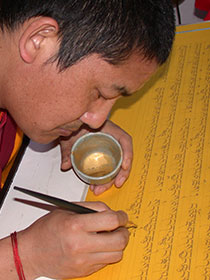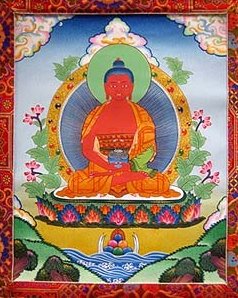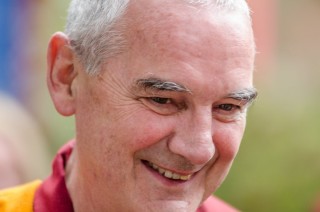- Home
- FPMT Homepage

Foundation for the Preservation of the Mahayana Tradition
The FPMT is an organization devoted to preserving and spreading Mahayana Buddhism worldwide by creating opportunities to listen, reflect, meditate, practice and actualize the unmistaken teachings of the Buddha and based on that experience spreading the Dharma to sentient beings. We provide integrated education through which people’s minds and hearts can be transformed into their highest potential for the benefit of others, inspired by an attitude of universal responsibility and service. We are committed to creating harmonious environments and helping all beings develop their full potential of infinite wisdom and compassion. Our organization is based on the Buddhist tradition of Lama Tsongkhapa of Tibet as taught to us by our founders Lama Thubten Yeshe and Lama Thubten Zopa Rinpoche.
- Willkommen
Die Stiftung zur Erhaltung der Mahayana Tradition (FPMT) ist eine Organisation, die sich weltweit für die Erhaltung und Verbreitung des Mahayana-Buddhismus einsetzt, indem sie Möglichkeiten schafft, den makellosen Lehren des Buddha zuzuhören, über sie zur reflektieren und zu meditieren und auf der Grundlage dieser Erfahrung das Dharma unter den Lebewesen zu verbreiten.
Wir bieten integrierte Schulungswege an, durch denen der Geist und das Herz der Menschen in ihr höchstes Potential verwandelt werden zum Wohl der anderen – inspiriert durch eine Haltung der universellen Verantwortung und dem Wunsch zu dienen. Wir haben uns verpflichtet, harmonische Umgebungen zu schaffen und allen Wesen zu helfen, ihr volles Potenzial unendlicher Weisheit und grenzenlosen Mitgefühls zu verwirklichen.
Unsere Organisation basiert auf der buddhistischen Tradition von Lama Tsongkhapa von Tibet, so wie sie uns von unseren Gründern Lama Thubten Yeshe und Lama Thubten Zopa Rinpoche gelehrt wird.
- Bienvenidos
La Fundación para la preservación de la tradición Mahayana (FPMT) es una organización que se dedica a preservar y difundir el budismo Mahayana en todo el mundo, creando oportunidades para escuchar, reflexionar, meditar, practicar y actualizar las enseñanzas inconfundibles de Buda y en base a esa experiencia difundir el Dharma a los seres.
Proporcionamos una educación integrada a través de la cual las mentes y los corazones de las personas se pueden transformar en su mayor potencial para el beneficio de los demás, inspirados por una actitud de responsabilidad y servicio universales. Estamos comprometidos a crear ambientes armoniosos y ayudar a todos los seres a desarrollar todo su potencial de infinita sabiduría y compasión.
Nuestra organización se basa en la tradición budista de Lama Tsongkhapa del Tíbet como nos lo enseñaron nuestros fundadores Lama Thubten Yeshe y Lama Zopa Rinpoche.
A continuación puede ver una lista de los centros y sus páginas web en su lengua preferida.
- Bienvenue
L’organisation de la FPMT a pour vocation la préservation et la diffusion du bouddhisme du mahayana dans le monde entier. Elle offre l’opportunité d’écouter, de réfléchir, de méditer, de pratiquer et de réaliser les enseignements excellents du Bouddha, pour ensuite transmettre le Dharma à tous les êtres. Nous proposons une formation intégrée grâce à laquelle le cœur et l’esprit de chacun peuvent accomplir leur potentiel le plus élevé pour le bien d’autrui, inspirés par le sens du service et une responsabilité universelle. Nous nous engageons à créer un environnement harmonieux et à aider tous les êtres à épanouir leur potentiel illimité de compassion et de sagesse. Notre organisation s’appuie sur la tradition guéloukpa de Lama Tsongkhapa du Tibet, telle qu’elle a été enseignée par nos fondateurs Lama Thoubtèn Yéshé et Lama Zopa Rinpoché.
Visitez le site de notre Editions Mahayana pour les traductions, conseils et nouvelles du Bureau international en français.
Voici une liste de centres et de leurs sites dans votre langue préférée
- Benvenuto
L’FPMT è un organizzazione il cui scopo è preservare e diffondere il Buddhismo Mahayana nel mondo, creando occasioni di ascolto, riflessione, meditazione e pratica dei perfetti insegnamenti del Buddha, al fine di attualizzare e diffondere il Dharma fra tutti gli esseri senzienti.
Offriamo un’educazione integrata, che può trasformare la mente e i cuori delle persone nel loro massimo potenziale, per il beneficio di tutti gli esseri, ispirati da un’attitudine di responsabilità universale e di servizio.
Il nostro obiettivo è quello di creare contesti armoniosi e aiutare tutti gli esseri a sviluppare in modo completo le proprie potenzialità di infinita saggezza e compassione.
La nostra organizzazione si basa sulla tradizione buddhista di Lama Tsongkhapa del Tibet, così come ci è stata insegnata dai nostri fondatori Lama Thubten Yeshe e Lama Zopa Rinpoche.
Di seguito potete trovare un elenco dei centri e dei loro siti nella lingua da voi prescelta.
- 欢迎 / 歡迎
简体中文
“护持大乘法脉基金会”( 英文简称:FPMT。全名:Foundation for the Preservation of the Mahayana Tradition) 是一个致力于护持和弘扬大乘佛法的国际佛教组织。我们提供听闻,思维,禅修,修行和实证佛陀无误教法的机会,以便让一切众生都能够享受佛法的指引和滋润。
我们全力创造和谐融洽的环境, 为人们提供解行并重的完整佛法教育,以便启发内在的环宇悲心及责任心,并开发内心所蕴藏的巨大潜能 — 无限的智慧与悲心 — 以便利益和服务一切有情。
FPMT的创办人是图腾耶喜喇嘛和喇嘛梭巴仁波切。我们所修习的是由两位上师所教导的,西藏喀巴大师的佛法传承。
繁體中文
護持大乘法脈基金會”( 英文簡稱:FPMT。全名:Found
ation for the Preservation of the Mahayana Tradition ) 是一個致力於護持和弘揚大乘佛法的國際佛教組織。我們提供聽聞, 思維,禪修,修行和實證佛陀無誤教法的機會,以便讓一切眾生都能 夠享受佛法的指引和滋潤。 我們全力創造和諧融洽的環境,
為人們提供解行並重的完整佛法教育,以便啟發內在的環宇悲心及責 任心,並開發內心所蘊藏的巨大潛能 — 無限的智慧與悲心 – – 以便利益和服務一切有情。 FPMT的創辦人是圖騰耶喜喇嘛和喇嘛梭巴仁波切。
我們所修習的是由兩位上師所教導的,西藏喀巴大師的佛法傳承。 察看道场信息:
- FPMT Homepage
- News/Media
-
- Study & Practice
-
-
- About FPMT Education Services
- Latest News
- Programs
- New to Buddhism?
- Buddhist Mind Science: Activating Your Potential
- Heart Advice for Death and Dying
- Discovering Buddhism
- Living in the Path
- Exploring Buddhism
- FPMT Basic Program
- FPMT Masters Program
- FPMT In-Depth Meditation Training
- Maitripa College
- Lotsawa Rinchen Zangpo Translator Program
- Universal Education for Compassion & Wisdom
- Online Learning Center
-
- Prayers & Practice Materials
- Overview of Prayers & Practices
- Full Catalogue of Prayers & Practice Materials
- Explore Popular Topics
- Benefiting Animals
- Chenrezig Resources
- Death & Dying Resources
- Lama Chopa (Guru Puja)
- Lama Zopa Rinpoche: Compendium of Precious Instructions
- Lama Zopa Rinpoche: Life Practice Advice
- Lama Zopa Rinpoche Practice Series
- Lamrim Resources
- Mantras
- Prayer Book Updates
- Purification Practices
- Sutras
- Thought Transformation (Lojong)
- Audio Materials
- Dharma Dates - Tibetan Calendar
- Translation Services
- Publishing Services
- Ways to Offer Support
- Prayers & Practice Materials
-
- Teachings and Advice
- Find Teachings and Advice
- Lama Zopa Rinpoche Advice Page
- Lama Zopa Rinpoche: Compendium of Precious Instructions
- Lama Zopa Rinpoche Video Teachings
- ༧སྐྱབས་རྗེ་བཟོད་པ་རིན་པོ་ཆེ་མཆོག་ནས་སྩལ་བའི་བཀའ་སློབ་བརྙན་འཕྲིན།
- Podcasts
- Lama Yeshe Wisdom Archive
- Buddhism FAQ
- Dharma for Young People
- Resources on Holy Objects
- Teachings and Advice
-
-
*If a menu item has a submenu clicking once will expand the menu clicking twice will open the page.
-
-
- Centers
-
- Teachers
-
- Projects
-
-
-
-
*If a menu item has a submenu clicking once will expand the menu clicking twice will open the page.
-
-
- FPMT
-
-
-
-
-
Buddhism is not saying that objects have no beauty whatsoever. They do have beauty. The craving mind, however, projects onto an object something that is beyond the relative level, which has nothing to do with that object. That mind is hallucinating, deluded and holding the wrong entity.
Lama Thubten Yeshe
-
-
-
- Shop
-
-
-
The Foundation Store is FPMT’s online shop and features a vast selection of Buddhist study and practice materials written or recommended by our lineage gurus. These items include homestudy programs, prayers and practices in PDF or eBook format, materials for children, and other resources to support practitioners.
Items displayed in the shop are made available for Dharma practice and educational purposes, and never for the purpose of profiting from their sale. Please read FPMT Foundation Store Policy Regarding Dharma Items for more information.
-
-
Life on the Road with Lama Zopa Rinpoche
13
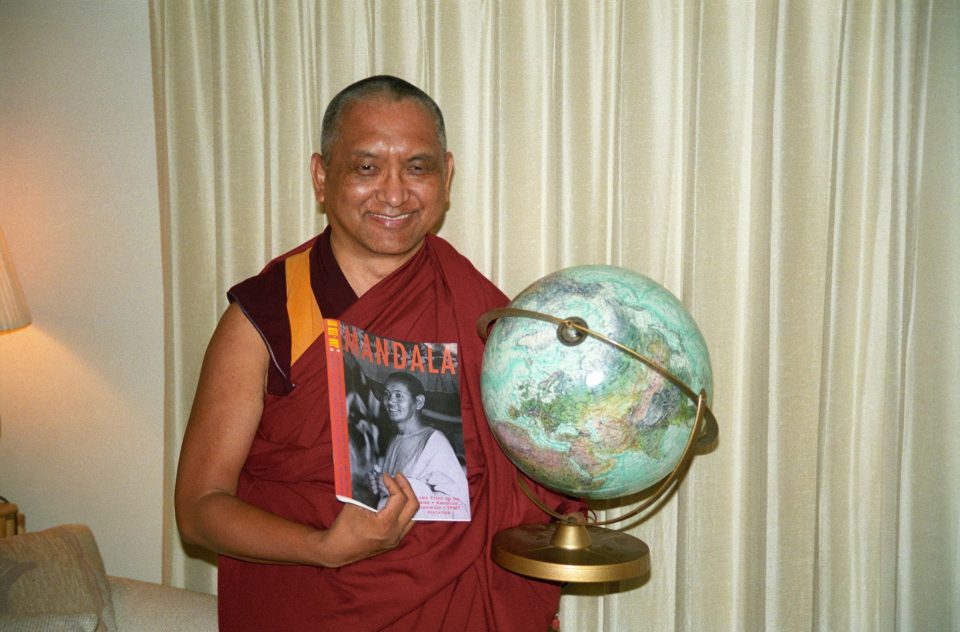
Lama Zopa Rinpoche in California, 1997. Photo by Ven. Roger Kunsang.
Over the years, students have shared stories from Lama Zopa Rinpoche’s travels around the world benefiting others; to offer a glimpse into what it is like to be on the road with Rinpoche, and to witness and participate in Rinpoche’s enlightened activity. These stories offer a glimpse into how Rinpoche used all of the circumstances in daily life, including the time traveling, to practice Dharma and serve others. Today we are sharing a report from 1997 from long-time FPMT student and former director of FPMT Education Services, Merry Colony.
The summer of ’97 could well indicate a new beginning in the travel style of Lama Zopa Rinpoche. Certainly, given the advice of one of his main teachers Ribur Rinpoche and others regarding Rinpoche’s hectic touring schedules and the consequent toll on his health, we should all pray for such.
At a slower pace, with greater autonomy and fewer scheduled events, Roger Kunsang, Roger Munro and our precious Rinpoche left California in the first days of August and embarked on the USA tour, but this time in a luxury conversion Dodge Ram van, maroon of course, complete with custom seats, TV and VCR. On this tour there would not be the constant hum of departure gate announcements, delays at baggage claim carousels or curbside’s anxious check-in crowds. Nor would there be the khatas given in haste amongst rushing onlookers. A great start to what can hopefully become the downsizing of Lama Zopa Rinpoche’s annual travel agenda.
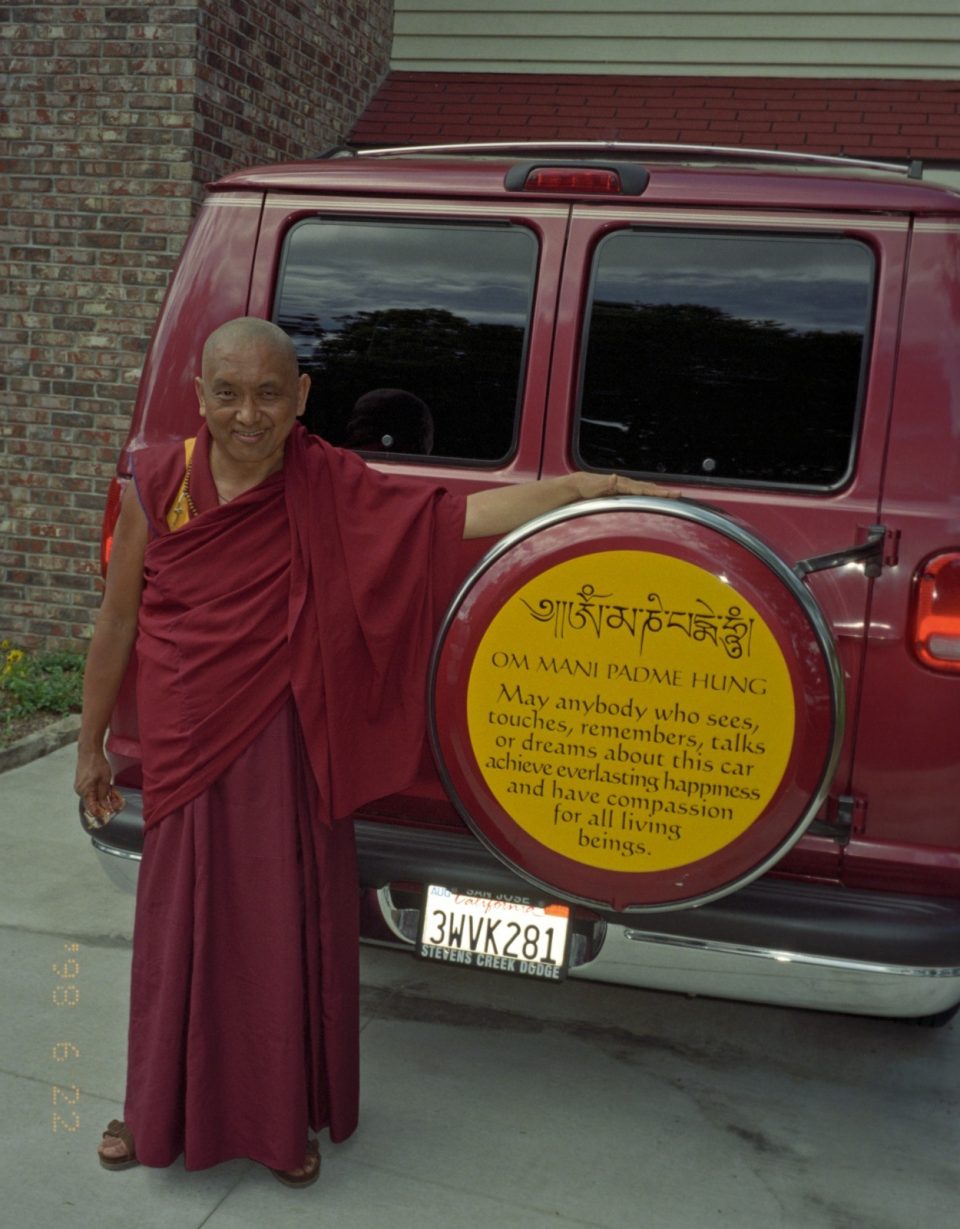
Rinpoche always taking every opportunity from daily life to bless others: The “vajra vehicle” Dodge van, 1998. Photo by Ven. Roger Kunsang.
As a method for giving teaching to us, the style in which Rinpoche traveled, ate and rested provided a whole new market of opportunities for him to show us how to create merit amidst the more ordinary scenery of daily life. The most consistent way in which Rinpoche did this, Roger Munro said, was to make the environment, at every moment, were, into a merit field. That Dodge van, be assured, was power-packed, bestowing blessings on all who were in its reach and providing those within with the means to create merit almost effortlessly. And if there is anything that comes close to death as being a definite in our lives, it is that we will ride in our vehicles. So how to use them for merit? Fill them with holy objects and then circumambulate them at rest strops, parking lots and shopping malls. That’s what Rinpoche did!
The route the entourage followed, starting off in Santa Cruz in California, was first through Nevada where the first night was spent on the side of the road, Rinpoche sitting up all night on the platform bed inside the van, Ven. Roger and Roger on the ground outside. When Roger 2 awoke in the morning, a bit disoriented, the first utterance he made was, “Where are we?” From inside the van a muffled voice replied, “In hell!” For the most part, however, Rinpoche remained quiet as they drove through the desert of Nevada, except to remark now and then on how a particular mountain “looked angry” or another “like an animal with its skin ripped off.” In Arizona Rinpoche was asked if he would like to see the Grand Canyon. “A hole in the ground! What for?” he replied.
When they reached Salt Lake City, Utah the atmosphere within the vajra vehicle and in the surrounding environment changed. There were several rainbows and a thin white cloud resting on the mountains surrounding the city, “as if a kata were draped on them,” Roger M. said. Rinpoche commented that the local deities seemed pleased and then got out to inspect the salt lake, the first interest he’d actively taken in the scenery so far. Roger M. reflected on how in his previous life the Lawudo Lama had made trips by foot to Tibet to buy salt. There may well have been a connection as Rinpoche seemed very interested in how and why and what kind of salt was there. After a visit with the family of Gomo Tulku they continued on to Wyoming and then Nebraska.
It was here, in the flatlands of middle America, that Rinpoche gave one of his best teachings. As it happened there was a Wheel Turning Day, August 7, when all the merits accumulated were multiplied ten million times. There were no stupas nearby, no statues, no Dharma centers. Except of course the unbelievably powerful objects that Rinpoche carries with him, and needless to say Rinpoche’s holy body itself. Within an hour the Motel 8 room where they had spent the previous night was transformed into a gompa and other than to eat lunch in the park nearby and bless the sentient beings living in the Platt river, the three did not leave the hotel room/gompa all day. They circumambulated a small formica table in the room adorned with their mani wheels, statues and the most precious stupa Rinpoche carries containing the Buddha’s relic. They prostrated to the makeshift altar where Rinpoche had set up laminated sheets of Lama Tsong Khapa and Medicine Buddha. And all around they set up water bowls, of the plastic Park Inn variety courtesy of the motel. Then they meditated on the purpose of the perfect human life, and making it worthwhile by accumulating merit on behalf of sentient beings and dedicating all the merits to them. The example shown has to make us ask: Is there really that much I need to make my life worthwhile?
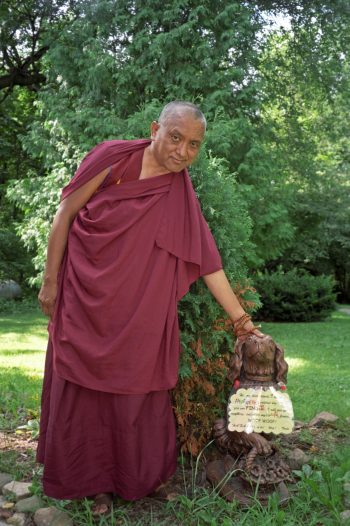
Dog with Dharma message written by Lama Zopa Rinpoche at Deer Park, Wisconsin, USA, 1997. Photo by Ven. Roger Kunsang.
The next stop was Deer Park, Wisconsin, the home of Geshe Sopa Rinpoche, one of Lama Zopa Rinpoche’s teachers. The entourage spent twelve days here, Rinpoche receiving teachings for two hours every day from Geshe-la. At the end Rinpoche offered a long life puja for Geshe Sopa, for which he shopped at the local department store, buying among other things, an Edgewood dinner set. The tsog offering was three tiers of gaudy supermarket cake, one of which had a smily face decorated in three-inch- thick frosting. Geshe-la was extremely pleased. When it came to the part in the puja where the mandala is offered and an original memorized praise is recited to the Lama, the tables were untraditionally turned. Rather than Lama Zopa offering the praise, Geshe Sopa himself spoke a moving praise of Lama Zopa’s extraordinary qualities as a yogi-practitioner. Before leaving Deer Park Rinpoche granted the Vajrasattva empowerment, at the request of Geshe Sopa, to the many students of Geshe-la who were present.
On to Decatur, Illinois. At Tilopa Center Rinpoche taught for three nights on The Three Principal Aspects of the Path followed by a Four-Armed Chenrezig empowerment. At a picnic Rinpoche is known to have given his first tattoo. On the forearm of a tattoo artist Rinpoche wrote, “The moment you remember death all other problems will be solved.” The man went home that night and put the needle and ink to the words. Yet another skillful means of bringing the teachings into our daily life American reality.
By now Ven. Tsenla had joined Rinpoche’s entourage and they drove back West to Osel Shen Phen Ling in Missoula, Montana. Director Deanna Sheriff wrote, “Rinpoche transformed our environment and all who came in touch with him. He has challenged us to build a stupa in Montana for the benefit of all who live here and particularly for the growing Tibetan community. We are delighted to fulfill his vision for us. We are also trying to hold Rinpoche’s vision of a bigger center in our visualizations and we invite students worldwide to pray for our success.” The vajra mobile then headed to the Dharma Friendship Foundation in Seattle for a Vajrasattva empowerment and public talk, then on to San Francisco for another Vajrasattva empowerment sponsored by Tse Chen Ling Center and attended by 200 people.
Being the first stop of a month-long program in California, S an Francisco saw the beginnings of an international audience with several Taiwanese in attendance. From there the venue moved south to Cupertino’s Medicine Buddha’s Healing Center. Here the numbers swelled, with students that had come from New Zealand, Europe, Nepal and Taiwan for the Heruka and Vajra Yogini initiations preceded each night by extensive lam-rim teachings. Rinpoche used Lama Yeshe’s text for the Heruka and would periodically read notes to us that Lama written as well as stopping where Lama had stopped when he had given the initiation years ago. It was a heartfelt touch for those of us who had attended those very memorable initiations.
Land of Medicine Buddha in Soquel hosted the next event, a Palden Lhamo empowerment. Co-director Mark Gatter tells of having lunch with Rinpoche the day of the empowerment when it was discovered that Rinpoche didn’t actually have the text with him. This inspired several Roger-powered long distance cellphone calls from the table until a text was located in Australia. They then returned to the center where the text was faxed through. Only when Rinpoche had started the preparation was it discovered that there were some pages missing. More calls to Australia. Just then three monks from Nalanda Monastery in France arrived, one of them carrying the exact text Rinpoche was in need of. He had brought it as an auspicious offering to the guru! Said Mark: “Don’t you just love this stuff?” The initiation then proceeded without a hitch, the gompa filled with students from all over the world, finishing at 5am.
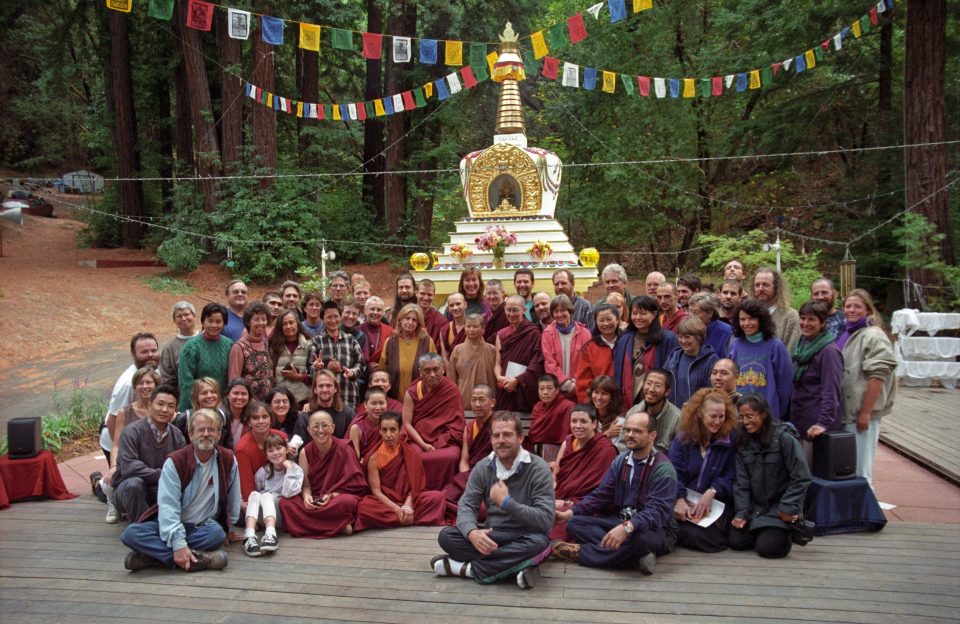
Lama Zopa Rinpoche with Most Secret Hayagriva retreat group at Vajrapani Institute, 1997. Photo by Ven. Roger Kunsang.
And now we bring you to date, where, as of writing, nearby at Vajrapani Institute, the extremely auspicious Dharma event of seventy students and Rinpoche doing a Most Secret Hayagriva retreat is in its final days. Many in attendance had followed the eight days of initiations preceding the retreat which had finished each night between 3 and 5am. When on the first day of retreat Rinpoche announced that this was “not going to be picnic,” a slight panic could be felt in the room. Picnic it hasn’t been (in fact meals have been taken in silence and without undue lagging about). Spiritual feast is more the description. At the start, however, it looked as though Rinpoche may depart early and go to Dharamsala for teachings from His Holiness, but the decision to stay was made when Geshe Sopa advised Rinpoche to remain. From our hearts, thank you Geshe-la!
For twenty-four days, now, we have had the indescribable fortune of getting a taste for how the guru would have us meditate and conduct ourselves in retreat. First session at 5am, as with all sessions, began with extensive motivation and prostrations to the Thirty-five Buddhas followed usually by commentary and then the sadhana either chanted in Tibetan or done silently in one’s own language. Rinpoche had invited Sera Je Geshe Thubten Sonam to come as our puja leader. After session and breakfast 1000 water bowls were offered at the stupa of the most precious Lama Thubten Yeshe. Another session began at 9:30am and another at 3pm. The evening session at seven included commentary as well as extensive torma and tsog offerings. After sometimes forty-five minutes of Rinpoche’s elaborate dedication prayers, we usually got to bed well after midnight.
The amazing thing to experience was how our resistance to the heavy schedule became less and less, and while tiredness always lurked around the edges, it was very sustainable, and it even became enjoyable to be making such effort to make our lives meaningful.
We even had the merit to walk out of the gompa one session and see a seventeen-foot Medicine Buddha tangka hanging from the redwoods behind Lama’s stupa. This was Peter Iseli’s most recent offering (for nearby Land of Medicine Buddha), and Rinpoche honored him that night with praise and presents after extensive offerings and prayers had been made to the tangka Buddhas.
On the last morning of retreat Rinpoche explained that only since his being in the USA did the plan to do this Most Secret Hayagriva retreat take shape. He also said that he did not expect there to be as much interest as there was and that he was pleased with how the retreat went.
Rinpoche then said that he would like to dedicate the positive accumulation to His Holiness. A letter will be sent to His Holiness explaining that this is the first time in the West that a group has done this particular practice and that we would all like to dedicate the merits to be guided by the Compassionate Buddha in all our lives and never to be separate.
Finally Rinpoche paid tribute to Paula Chichester and Roger Munro, who are about to begin their second three-year retreat. “Bearing so much hardship, this is what I am most interested in. Generally people who have done three-year retreat, you don’t see much result, but I can see the improvement, stability. This is the result of having practiced Dharma during the retreat. Anyone can recite mantras but practicing Dharma is very difficult. When there is no development in the mind it is not because one doesn’t have mantras to recite or deity practice to do, it is because no Dharma practice gets done.” Rinpoche wished them both a good journey.
Tomorrow is fire puja and then as we all came together so we will part, each to their to their own destination, to their next work. We dedicate all the merits to all the FPMT students, benefactors, teachers and projects. That all may have success and that all obstacles be cleared.
And most of all that our lamas who show us the path, without whom we would not even know the name of Buddha, will have long and healthy lives and that all their holy wishes may be fulfilled without delay.
Written by Merry Colony for Mandala magazine, November-December 1997.
You can read more inspiring and amusing stories of Lama Zopa Rinpoche on the road we have previously published.
Foundation for the Preservation of Mahayana Tradition (FPMT), is a Tibetan Buddhist organization dedicated to the transmission of the Mahayana Buddhist tradition and values worldwide through teaching, meditation and community service.
10
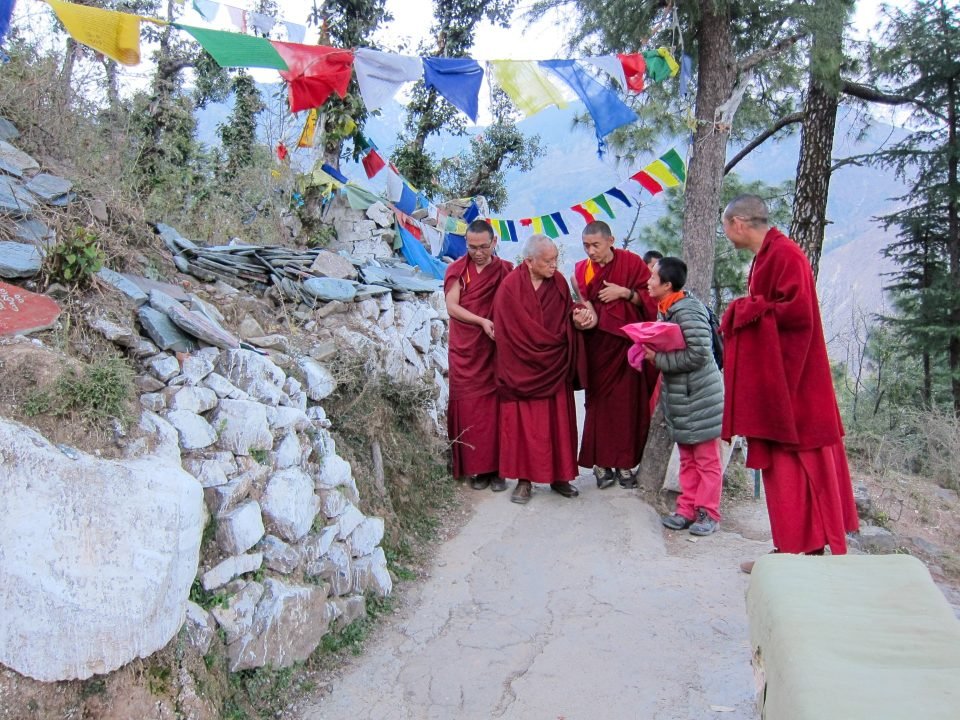
Lama Zopa Rinpoche in Dharamsala, 2012. Photo by Ven. Roger Kunsang.
Over the years, while traveling continuously with Lama Zopa Rinpoche, Ven. Roger Kunsang, CEO of FPMT and Rinpoche’s long-time attendant, would share stories of what it was like to be on the road with Rinpoche, and to witness and participate in Rinpoche’s enlightened activity. These stories offer a glimpse into how Rinpoche used all of the circumstances in daily life, including the time traveling, to practice Dharma and serve others. In 2012, Ven. Roger shared this story from the road in Dharamsala, India:
It’s very dark. There is a strong storm with blasting winds and the road is narrow with room for only one vehicle at a time. The road is on the edge of a cliff at least a 1,000-foot [305-meter] drop on one side – it makes you dizzy looking over the edge. The road is in bad condition: sometimes just gravel and rock, with too many holes really jarring the car. There is a truck coming the other way heading straight for us blasting its horn. (Indian trucks are big and heavy and often held together by wood! They are actually huge pieces of scrap metal on wheels with tires that have no tread or very little.) I have nowhere to go (it’s me driving) and I can’t figure how to avoid this oncoming scrap metal heap on wheels that moves like a crab. The roads are so narrow so when an oncoming vehicle appears, you have to find quickly where the road is a little wider so you can pass each other, otherwise you get stuck and someone has to reverse up. And even then it could be a long way and then you might find another car behind you and he is blasting his horn and the car behind him is blasting away on his horn. Actually, Indian drivers drive with one hand on the wheel and the other on the horn, and it is very acceptable. Anyway, I manage very luckily to find a place where we can pass and we continue in complete darkness. The journey is 12 hours so you really have to be alert all the time, like really alert!
Everyone has the right-of-way on the roads which is confusing, everyone thinks they own the road which also goes for pedestrians, cows, dogs and donkeys … earlier in the day we came across a guy on the phone rolling with his feet a large gas bottle down the middle of the road, the gas bottle picked up speed and he lost control which didn’t seem to be a problem for him as he continued talking on the phone as the gas bottle picked up more speed and headed straight for us! We swerved and all was fine as it is with Indian roads as there are no rules so no one is doing anything wrong so all is OK … I like it with no rules, but can’t handle the overtaking on blind curves, which is common. (I thought it appropriate to have no full stops when describing the roads here.)

Manikaran. Photo by John Hill. Creative Commons (Wikipedia)
Later that night we came across two trucks that just had had a head-on crash. There was no room to pass each other, so I guess they couldn’t get around each other so they decided to go through each other. It is very messy. Trying to get past this mess and not disappear over the edge of the cliff created some anxious moments. This is the drive to Manikaran from Dharamsala, where Rinpoche went for treatment in the hot springs.
It was a nice relaxing time with plenty of time to go to the hot springs, a holy place of Guru Nanak of the Sikh tradition. Still, Rinpoche’s focus seemed to be on others and we never had enough time to actually go to the hot springs apart from slipping in one short session here and there. Rinpoche instead focused on the local Tibetan community about four hours’ drive away (yes, on the worst roads ever). The community (near Manali) is where Song Rinpoche’s mother lived before coming to the US. A few years before Rinpoche had sponsored the main statues on the altar of the small gompa there. Rinpoche visited the place a couple of times and wants to have eight monks there and a proper small monastery, so Rinpoche made a proposal to the community to sponsor and set it up. Another time we visited this beautiful and amazing Kagyü temple not far away. Rinpoche was interested in the art and architecture. Then 12 hours back to Dharamsala again via the Tibetan community in Manali.
Now we are packed and ready to leave for Dehradun, about 10 hours’ drive from here. We should leave now but Rinpoche is still teaching (in the gompa of Tushita). We were supposed to leave yesterday, but didn’t. I already forgot why. Now waiting … hopefully, Rinpoche will finish soon. I’m so keen to get back on the Indian roads with no rules. No rules does make it easy.
Practices for Auspicious Travel
All are welcome to download various practices which Lama Zopa Rinpoche has recommended for clearing obstacles while engaged in travel, here are a few of these recommended practices:
- An Extremely Abbreviated Version of The Exalted Sutra ”Completely Dispelling the Darkness of the Ten Directions”
- Dharani Which Accomplishes All Aims
- A Ritual to Perform When Undertaking Activities on Inauspicious Days
- Tea Offering to the Eight Classes (De gyä) in the Protector Prayers
- Noble Stack of Auspiciousness
Foundation for the Preservation of Mahayana Tradition (FPMT), is a Tibetan Buddhist organization dedicated to the transmission of the Mahayana Buddhist tradition and values worldwide through teaching, meditation and community service.
14

Lama Zopa Rinpoche blessing mice, Buddha Amitabha Pure Land, Washington State, USA, November 2016.
Over the years, while traveling continuously with Lama Zopa Rinpoche, Ven. Roger Kunsang, CEO of FPMT and Rinpoche’s long-time attendant, would share stories of what it was like to be on the road with Rinpoche, and to witness and participate in Rinpoche’s enlightened activity.
In 2011, Ven. Roger shared this story about a very fortunate snake: It was dark, maybe 9 p.m., and there was something wriggling on the path going around Bouddha Stupa. It was a baby jet black snake! We got it onto an open piece of cardboard with a little difficulty. Rinpoche wanted it to come with us around the stupa. Rinpoche gave it the name, “Thubten Tharpkye.” For the next 10 circumambulations of the stupa the snake got some really good karma. At the end, after dedications (ending around midnight — almost no one is around at that time), we had to say good bye to Thubten Tharpkye. We placed him safely in the drainage system from where he must have come and will spend the rest of his life.
In 2016, a young snake was discovered at Buddha Amitabha Pure Land, Washington State, struggling to escape after getting stuck to some adhesive left on the wall of a retreat cabin. Lama Zopa Rinpoche and Sangha members freed the unhappy sentient being—apparently a harmless gopher snake—with a combination of water and mantras, Rinpoche named him “Jangsem,” Tibetan for “bodhichitta.” Rinpoche also decided to keep Jangsem in his own house for a while in the hope of improving his future rebirths. Thus the small snake entered into retreat, in a large plastic box, comfortably resting on an old towel! You can listen to Rinpoche reciting mantras for Jangsem the snake at this time:
Wish-fulfillment for all Animals
Lama Zopa Rinpoche compiled a list of mantras and buddhas’ names that are powerful for benefiting animals, Wish-fulfillment for all Animals: Their Happiness and
Additional Resources for Benefiting Animals
Liberating Animals from the Danger of Death: This short version of Liberating Animals is a profound method to prolong life and cure sickness. Relying on the truth of cause and effect, practitioners make special effort to give life and benefit to helpless creatures that are on the verge of being killed. By performing this powerful practice, we not only save these beings from immediate suffering, we also create the cause for their attainment of better future lives, from life to life to full enlightenment. The book also contains many practices and mantras that can be done to benefit living and sick animals.
Blessing the Animals in the Ocean: This practice can be done to bless the animals in any body of water, such as oceans, seas, lakes, and ponds. The blessing is done by reciting powerful mantras of Chenrezig and Namgyalma, plus other mantras, then blowing into the clean water before pouring the blessed water into the body of water with animals. Mantra boards such as Namgyalma Mantra board, if available, can be put into the body of water during the practice.
Animal Liberation Tool: This animal liberation tool can be used to catch small insects and remove them compassionately from your house. Designed by Lama Zopa Rinpoche and covered with mantras that benefit bugs, as well as quotes that benefit humans, these bug catchers are not your ordinary bug catching jar!
Please also visit our webpage, Benefiting Animals: Practices and Advice, which contains many resources for those wishing to benefit animals in the most extensive ways possible: https://fpmt.org/education/prayers-and-practice-materials/benefiting-animals-practices-and-advice
Foundation for the Preservation of Mahayana Tradition (FPMT), is a Tibetan Buddhist organization dedicated to the transmission of the Mahayana Buddhist tradition and values worldwide through teaching, meditation and community service.
23

Lama Zopa Rinpoche, Ven. Roger Kunsang, and Markus Igel walking to subway in Vienna, Austria, September 2017. Photo by Lobsang Sherab.
In late September, Lama Zopa Rinpoche visited Panchen Losang Chogyen Gelugzentrum in Vienna, Austria. This was Rinpoche’s first official stay in Austria and his first visit to the FPMT center that was started nearly thirty-three years ago. There Rinpoche gave teachings, refuge, and the Great Medicine Buddha initiation.
Center founder and current spiritual program coordinator Andrea Husnik and center director Stefan Seidler were in attendance for Rinpoche’s monumental visit. The teachings were supported by a team of hard-working volunteers—many of whom had taken a week off work—who forewent meals and sleep, and gave their all in order to deliver incredible hospitality to Rinpoche and all participants.
Following the Light of the Path retreat, and a long flight from North Carolina, United States, to Austria, Rinpoche rested for a number of days with the Igel family at their home in Vienna. During his stay, Rinpoche was offered an apple strudel, which the mother of the family had made. The dish was so good that Rinpoche asked if he could be shown how to make the dessert. During the filming of an instructional video (see below), Rinpoche offered advice on how to cook for the benefit of others.
Rinpoche took a number of walks in the city parks, taking every opportunity to bless the dogs that he passed. While using the subway on his way to a restaurant, Rinpoche saw a homeless man to whom he made offerings. Throughout his stay, while Rinpoche walked through the streets of Vienna, he recited OM MANI PADME HUM out loud, blessing and benefiting everyone that he encountered.
Watch “How to Cook Apple Strudel and Actualize the Path to Enlightenment” on YouTube
Rinpoche’s recorded teachings in Vienna, Austria, are available as a part of Rinpoche Available Now:
https://fpmt.org/media/streaming/teachings-of-lama-zopa-rinpoche/lama-zopa-rinpoche-teachings-vienna-tabs/
View a gallery of images from Lama Zopa Rinpoche’s visit to Austria:
https://fpmt.org/teachers/zopa/gallery/austria-vienna-september-october-2017/
More information, photos, and updates about FPMT spiritual director Lama Zopa Rinpoche can be found on Rinpoche’s webpage on FPMT.org. If you’d like to receive news of Lama Zopa Rinpoche and FPMT via email, sign up to FPMT News.
- Tagged: austria, lama zopa rinpoche, om mani padme hum
1
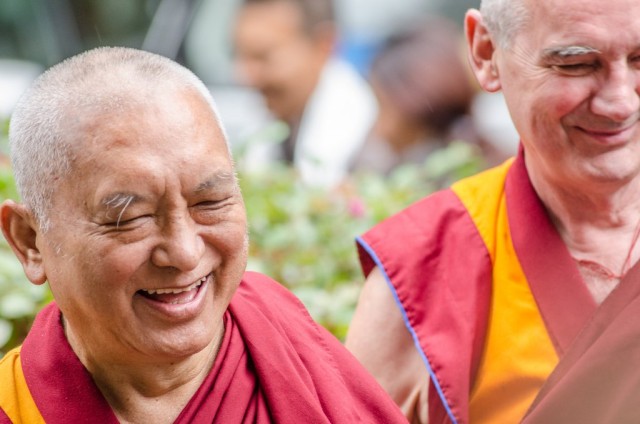
Lama Zopa Rinpoche with Ven. Roger Kunsang arriving at Land of Medicine Buddha, California, September 21, 2013. Photo by Chris Majors.
From Ven. Roger Kunsang:
Kachoe Dechen Ling, Aptos, California, October 31, 2013 —
Sunday, October 13, 5 p.m., Rinpoche is giving the Amitabha long life initiation in San Jose at Gyalwa Gyatso Buddhist Center. Good timing as usually initiations with Rinpoche are late-night events or even all-night events. As this is a long life initiation, it should be given in the morning. Well, it started in the morning, at about 10 a.m., and with no break for lunch, it was still going into the evening. All the students attending seemed happy and relaxed even though they missed lunch. Rinpoche taught throughout the day, and only when evening came did he start the initiation … and finished it quite quickly!
As Rinpoche always says the main benefit is in the lam-rim/motivation prior to the initiation. His Holiness the Dalai Lama often says the same. One of the main reasons for giving the Kalachakra initiation, His Holiness says, is to get a lot of people in one place to hear the lam-rim teachings that happen prior to giving the Kalachakra. “[It’s] my business,” His Holiness says. “I offer Kalachakra initiation to get as many people here as possible for the lam-rim. If I just offer the lam-rim, most won’t come, just the Sangha.”
Rinpoche started the preparation at about 8:30 a.m. At around 10:30 a.m., the motivation for the initiation started. At around 6 p.m., Rinpoche had been sitting without food for nearly 10 hours, so I cut up a banana and offered it to Rinpoche while he was teaching. (We have to be careful of Rinpoche’s sugar level going to low.) Rinpoche ate two small slices and quickly continued the initiation.
Rinpoche was giving the Amitabha initiation sitting on a chair, the same aspect as Maitreya. Rinpoche did this because the initiation was given to him by His Eminence Chogye Trichen Rinpoche, one of the main high lamas of the Sakya tradition, while sitting in a chair. His Holiness Dujom Rinpoche, the main high lama of the Nyingma tradition, gave the initiation to Chogye Trichen Rinpoche while sitting in a chair. Sitting in a chair giving the initiation is part of this tradition, and actually, most of the people at Gyalwa Gyatso Center were receiving the initiation sitting in chairs!
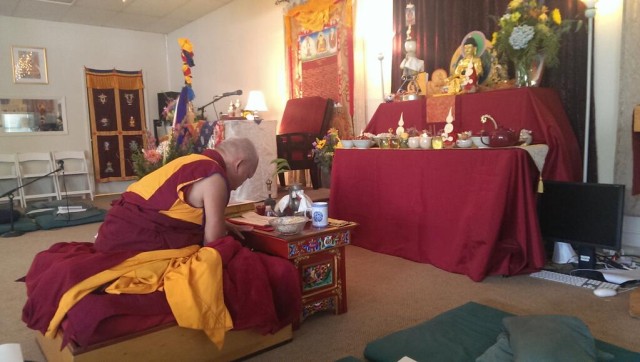
Lama Zopa Rinpoche preparing for Amitabha long life initiation at Gyalwa Gyatso Buddhist Center, California, October 13, 2013. Photo by Ven. Roger Kunsang.
In the late ‘80s or early ‘90s, Lama Zopa Rinpoche was giving the Heruka Body Mandala commentary at Vajrapani Institute in California and was to give the Amitabha initiation later in Texas where student Dr. Chu Nan Lai and the Chinese community there had requested the initiation. After finishing at Vajrapani, Rinpoche said to me near the end of the Heruka commentary, “I have to receive the Amitabha initiation before I can give it!” His Eminence Chogye Trichen Rinpoche was teaching in Boston at the time, so Rinpoche said he would request the initiation from Rinpoche so he could give it in Texas.
The difficulty was that there was very little time (a few days) before Rinpoche had to give the initiation in Texas and we had so much luggage (mostly texts) and there was only Rinpoche and me. It was complicated for a number of reasons, mainly because arrangements were last minute. So this was the plan: I made the arrangement for Rinpoche to fly alone across the US to Boston where at the airport Tim McNeill was to pick up Rinpoche and drive straight to where Chogye Trichen Rinpoche was waiting to give the initiation to Rinpoche. As soon as the initiation was finished, Tim had to drive Rinpoche straight to the airport in Boston and then Rinpoche alone would board the flight to Houston, Texas where I would meet Rinpoche. I wrote all the details down for Rinpoche as Rinpoche had not flown alone before. I was nervous about doing this, but there seemed no choice.
The next day it all happened. Rinpoche flew to Boston and arrived in the morning. The initiation happened immediately, and as soon as it finished, Rinpoche was driven to the airport and on the flight from Boston to Houston, Texas. I was in Houston waiting at the airport with Chui Nan Lai and many students for Rinpoche to arrive on his flight. It was late night and Rinpoche was on the last flight (in fact, the airport was closing). The flight landed and everyone came off. But there was no Rinpoche. People got worried, but I said its OK as Rinpoche is always the last off the flight because he always waits till everyone else leaves. We waited. I was getting worried, so we asked the flight attendant, and she said there was no Tibetan lama on the flight! Then we spoke to another agent and she checked what happened. She said something happened in Cincinnati as Rinpoche had to change flights there. (This was the part I was worried about, but I had given Rinpoche a note explaining the details of the transit, so was hoping it would be OK.) Rinpoche had missed his connection in Cincinnati and had been put on a later flight and that flight was landing now in another airport on the other side of Houston.
We all rushed and drove across the city hoping to get there in time to meet the flight. When we arrived, the flight had landed and the airport was closing, but there was no Rinpoche in sight! Students split up and went in different directions searching for the lost Rinpoche who had to give the newly acquired Amitabha initiation the next day. We couldn’t find Rinpoche anywhere … so strange! So we went outside the airport to look. I went into the park close by. Now it was late at night, so dark … small nervous freak-out happening … but suddenly I came across Rinpoche sitting cross legged in the dark under a bush! I was very relieved, but at the same time couldn’t help but ask Rinpoche why he hadn’t stayed in the airport where we could find him easily; we were all really worried. Rinpoche said simply, “You found me didn’t you!”
Next day the initiation happened and all were very happy.
Rinpoche and I were then scheduled to fly to Nepal for the November course. This was at the end of a long international teaching tour. Actually, it began several years before (when Lama Yeshe passed away) and hadn’t stopped. It just went on and on. From one center to another, we barely had two or three days between centers; it was a really grueling, hard day’s night that never ended; days and nights merged; weekends didn’t exist; years went by. I would always be asking Rinpoche to consider rest, to just take one day off, even a few hours at night, but Rinpoche would always ignore me. After some years, I asked Rinpoche what does “rest” mean to Rinpoche? Rinpoche said, “Abiding in virtue.” After that, I think I gave up on the rest issue and the phrase that immediately arose in my mind so vividly was “this is the bodhisattva’s way of life!”
Anyway, we were now in Houston and Rinpoche said to me, “Maybe you need a little holiday.” I was really surprised to hear Rinpoche say this. It had been many years constantly on the road and suddenly Rinpoche was talking about me having a holiday. Rinpoche said we could stop in Hawaii on the way back to Nepal and stay two days at our center there. It was really hard to believe, but of course I made the arrangements. We arrived in Hawaii and the center directors Molly and Danny picked us up and we drove to the small center on the big island. It was supposed to be a relaxing time, but it got busy almost as soon as we arrived with pujas for people. Tormas had to be made, and I was the torma maker. So the weekend was busy. We were scheduled to leave on a flight Monday morning very early. Sunday evening, just after it got dark, Rinpoche said, “Oh! I forgot about Roger’s holiday, where shall we go? So we drove along the coast in the dark, and Danny and Molly pointed out the nice beaches as we drove, which you couldn’t see in the dark, and we returned to the center after 45 minutes. So that was the holiday. We left early the next morning. Rinpoche seemed very happy that Roger had had his holiday: 45 minutes’ drive in the dark. (I’m not complaining … it was just shorter than I thought and the lights were out.)
Lama Zopa Rinpoche is the spiritual director of the Foundation for the Preservation of Mahayana Tradition (FPMT), an organization dedicated to preserving Mahayana Buddhism through offering the Buddha’s authentic teachings and to facilitating reflection, meditation, practice and the opportunity to actualize and directly experience the Buddha’s teachings. Sign up to receive news and updates.
- Tagged: amitabha long life initiation, gyalwa gyatso (ocean of compassion) buddhist center, hawaii, houston, lama zopa rinpoche, ven. roger kunsang
- 0
10
Dharmachakra Offered Twice
From Ven. Roger Kunsang:
Dharamsala, India – June 4, 2013
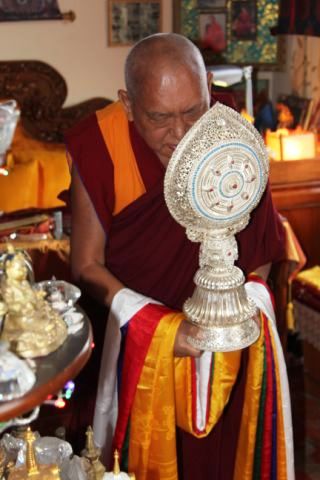
Lama Zopa Rinpoche offers Dharmachakra virtually the first time to His Holiness the Dalai Lama, Kopan, Nepal, May 2013. Photo by Ven. Roger Kunsang.
Very early in the morning Rinpoche decides to go to the long life initiation His Holiness the Dalai Lama is giving at the temple here in McLeod Ganj. So far, Rinpoche has been watching the webcast from Tushita [Meditation Centre]. We did try to explain to Rinpoche it would be difficult for different reasons. Rinpoche was very insistent he will go! Rinpoche wanted to offer the large 30-inch (76-centimeter) silver Dharmachakra to His Holiness. A small thing to get through security (never mind we didn’t have teaching passes either.)
During His Holiness’ visit to IOF [International Office] in Portland, Rinpoche offered this beautiful silver Dharmachakra to His Holiness on video. We took the video of Rinpoche offering, visualizing His Holiness, while Rinpoche was in Kopan, then emailed the video to Portland and there George, Ven. Holly [Ansett] and Tom [Truty] arranged for the video to be played to His Holiness after Tenzin Ösel Hita offered the body, speech and mind [mandala]. His Holiness watched the video of Rinpoche humbly offering the Dharmachakra and joined in the chant when Rinpoche did the short mandala offering. Then His Holiness made the comment, “so sincere.”
Now Rinpoche was in the teachings near to His Holiness and at the end of the teachings, after the mandala offering, Rinpoche managed to get to his feet and go up to His Holiness’ throne as best as he could holding the large silver Dharmachakra as high as he could, the five different colored khatas underneath. Rinpoche approached the throne bending down humbly and trying to hold the Dharmachakra high to offer to His Holiness. His Holiness, with arms stretched out and bending down low from the throne, was making an effort to try and reach the Dharmachakra, but then Rinpoche was bending even lower and it didn’t look like His Holiness could reach – this wasn’t going to work! Suddenly somehow they connected and finally His Holiness actually received the Dharmachakra first offered on video!
His Holiness said to Tashi-la, the ritual attendant to His Holiness the Dalai Lama, to put the Dharmachakra in front of the large Padmasambhava statue on the main altar. That seemed really auspicious and special. Such a moving offering, it really did feel like something significant.
Ven. Roger Kunsang is CEO of FPMT and assistant to FPMT spiritual director Lama Zopa Rinpoche.
To keep up to date with “Life on the Road with Lama Zopa Rinpoche,” consider signing up for our RSS feed (in the right-hand column of this page).
22
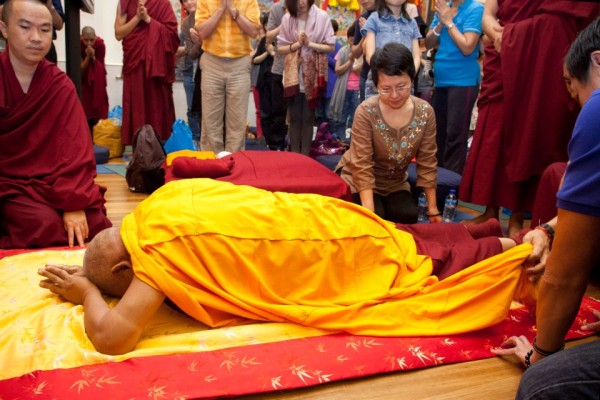
Lama Zopa Rinpoche making prostrations at Amitabha Buddhist Centre, Singapore, March 10, 2013. Photo courtesy of www.facebook.com/fpmtABC.
From Ven. Roger Kunsang:
Hong Kong – March 22, 2013
Rinpoche stood with his hands in the mudra of prostration before a very large thangka of Chenrezig. Rinpoche gradually leaned forward, slowly going to the ground, his stronger left arm reached for the ground, fingers contacted the floor. Gradually, Rinpoche put weight on the arm as his body leaned forward cautiously. The left knee moved towards the ground and made contact. Now the hard part: the right arm reached out to touch the ground with Rinpoche trying to spread his fingers so they landed open and stretched out on the floor.
I was feeling a little anxious as when Rinpoches head goes lower than the waist, he can feel dizzy and that’s a little dangerous after a stroke.
Gradually, Rinpoche lowered his body forward awkwardly, always the left side taking most of the weight. Watching Rinpoche making this kind of effort is very moving. I can see others moved and feeling emotional. The whole hall is very quiet while Rinpoche is making such an effort to do a full length prostration to all the Buddhas.
Rinpoche is now stretched full length on the floor although his right arm can’t straighten out yet. The process is slow but done with great, great determination. Now the really hard part: Rinpoche gets up alone as he won’t let anyone help! Rinpoche has developed a technique as he gradually rises where he shifts his weight over several stages, and finally to the stage where he has to take the weight from his arms and be on his legs only. That is most difficult. It’s quite tense watching this part and I can see some students who are watching, holding their breaths.
Rinpoche is hesitating now as he has to make a huge effort to go from kneeling to his feet … He does so and then straightens his body and is standing. His hands slowly come to his heart in the mudra of prostration in front of Chenrezig. Now two more prostrations and then the climb up on to the throne.
It wasn’t so long ago that Rinpoche couldn’t do this alone and it was dangerous as he would sometimes feel dizzy when his head went below the waist (not a good sign when you have problems with blood pressure and you have had a stroke!)
It’s very inspiring and moving to see Rinpoche do this with such determination. In the hospital immediately after the stroke, Rinpoche commented and also explained to His Holiness the Dalai Lama how sad he was that he couldn’t do even one prostration any more … or even bring both hands to the mudra of prostration at his heart to respect the Three Jewels. But now up to 12 long prostrations alone … that’s progress! Rinpoche is going in his own way at his own pace.
Ven. Roger Kunsang is CEO of FPMT and assistant to FPMT spiritual director Lama Zopa Rinpoche.
To keep up to date with “Life on the Road with Lama Zopa Rinpoche,” consider signing up for our RSS feed (in the right-hand column of this page).
5
New Video: Lama Zopa Rinpoche on Karma
- Tagged: fpmt taiwan, lama zopa rinpoche, taiwan, video
- 0
2
Dreaming in the Food Court
From Ven. Roger Kunsang:
Taiwan–March 2, 2013
We stopped for dinner, at a food court on the drive to Kaoshung. (We were driving from Taipei in the north to Kaoshung in the south of Taiwan. We got off to a late start as Rinpoche was trying to squeeze in as much as possible at Jinsui Farlin, our center in Taipei, before leaving.) It’s around midnight and not easy to find something open.
The food court had many small restaurants even an Irish Potato place … Hmmm delicious! But they were all closed except for a place specializing in pork dishes(!) and a coffee shop (midnight, can you imagine … coffee?). So we settled for the only thing existing for midnight vegetarians … tea/coffee and a sandwich of delicious white bread.
Rinpoche was sitting at the table with tea and delicious sandwich and seemed to be thinking contemplatively as he watched the people moving around in the shopping area (seeming to not have the slightest interest in the delicious sandwich). We all were very hungry, so not wanting to wait too long to eat the delicious sandwich.
Rinpoche then mentioned with a mixture of sadness and compassion, “When you don’t think of the next life … people are wandering, like in a dream, believing 100% the dream is real! Like in a illusion or mirage … believing it’s all real.” (Rinpoche was watching the people walking around very focused on the shops and shaking his head.)
Rinpoche continued, “Imagine walking around like this and no idea of your next life and that life is not according to your choice; it is up to karma we create. Most likely insects, jelly fish … what suffering. So knowing Dharma is a huge benefit! Wow wow wow, so so so fortunate having met Dharma. Knowing Dharma is a huge opening of the eyes; the need for money in this life becomes like nothing. So so so fortunate having met Dharma.”
UPDATE: Ven. Roger share’s a video from the food court.
Ven. Roger Kunsang is CEO of FPMT and assistant to FPMT spiritual director Lama Zopa Rinpoche.
To keep up to date with “Life on the Road with Lama Zopa Rinpoche,” consider signing up for our RSS feed (in the right-hand column of this page).
- Tagged: fpmt taiwan, lama zopa rinpoche, taiwan
- 0
16
A long time later, and no cough!
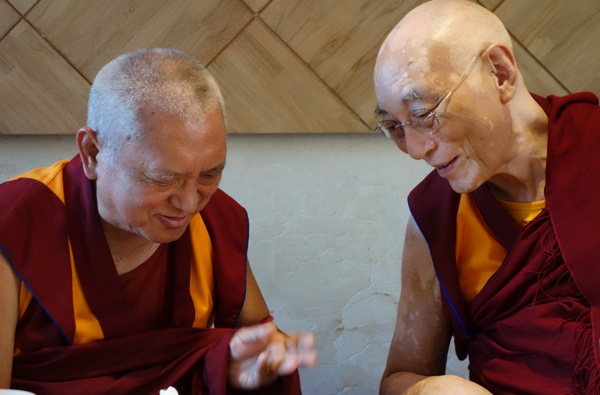
Lama Zopa Rinpoche and Choden Rinpoche, Taiwan, February 2013. Photo by Ven. Roger Kunsang.
Taichung, Taiwan — February 16, 2013
From Ven. Roger:
It’s been two years since Rinpoche has had the stroke. Not a lot has changed in Rinpoche’s life style actually. When Rinpoche had the stroke it happened gradually over several days … things got worse gradually, even after arriving at the hospital the stroke seemed to continue for several days. It got to the stage where Rinpoche physically was doing almost nothing, could hardly move. It was a serious stroke … he just lay there and it was very hard to know what to do. Rinpoche took absolutely no interest in his body. He never asked the doctor how he was or what he should do … what were his chances, will he be OK? Not the slightest concern did he seem to have about his critical condition. Rinpoche focused on prayers for the sick people in the hospital and even did a little fundraising for the (Christian) hospital in the later part of his stay.
And so nothing has changed over the last two years in this sense. Rinpoche seems not to have the slightest interest in recovering or not (but recovery is happening). This is hard to relate to for most people, why wouldn’t you want to get better … so you could help others. Prior to the stroke Rinpoche lived the same way … having no worldly concern or interest … everything was for others. There was no concern for sleep or any worldly benefit, no interest in rest. ( Rinpoche’s definition of rest was … abiding in virtue.) From my experience being with Rinpoche, there was no space for the eight worldly dharmas, there was no self cherishing … signs such as these was none.
So nothing has really changed in Rinpoche’s life … oops, there is one thing … Rinpoche doesn’t cough any more, especially in teachings! The more I think about Rinpoche’s life, and wonder, and try to understand, the more I think about Shantideva and the way of the bodhisattva warrior. Rinpoche is a warrior, and I think he has conquered the real enemy within and that’s maybe why it is hard to relate to him sometimes or understand his actions … because they are always opposite to the world. Rinpoche has no rush to go anywhere as he is already there. And as Rinpoche always says, “Taking care of others is the best way of taking care of yourself.”
This morning Rinpoche did 12 long prostrations unaided … quite an effort. We are in the 15 Days of Miracles, so Rinpoche is making an effort to use every minute to create merit. Yamantaka self initiation started a few days ago and is still not finished … it started with prostrations and then Lama Chopa and in between many other things kept happening … pujas, incense offering for people who are sick … this and that. The day finishes around 3 a.m., 4 a.m. is tea and then some prayers … a little rest after breakfast.
Video: Lama Zopa Rinpoche doing prostrations, Shakyamuni Center, February 2013
For the last few days Rinpoche has been visiting Choden Rinpoche to receive shabtu puja (clearing pollution) and also offering lunch to Choden Rinpoche. They sit together quietly, very peacefully and occasionally there is a little conversation and warm smile.
Today … right now Rinpoche is giving Dzambala initiation here at Shakyamuni Center, there could be as many as 500 people in the gompa. When the initiation finishes, the Yamantaka self initiation will continue. And so it goes on.
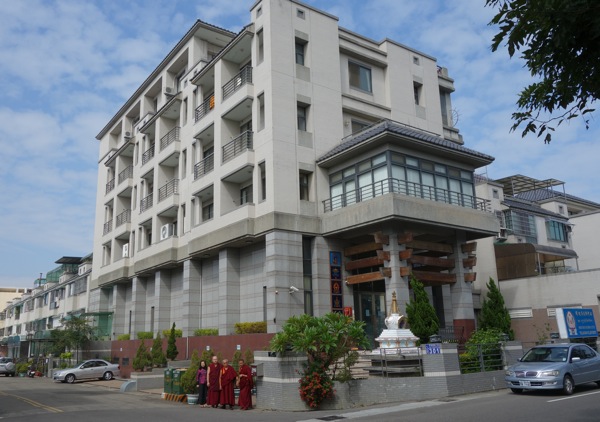
Rinpoche in front of Shakyamuni Center, Taichung, Taiwan, February 2013. Photo by Ven. Roger Kunsang.
Rinpoche’s blood pressure and sugar levels are OK. The doctors seem to be happy considering Rinpoche’s situation. And although Rinpoche has no interest in the conventional types of exercise … very gradually there seems to be improvement in his right leg and arm, the arm being the slowest to improve but it does seem to be improving.
Most days here Rinpoche does long prostrations and then walks up the stairs to the top floor where he stays … six stories. It leaves most of us puffing, and Rinpoche manages OK.
Ven. Roger Kunsang is CEO of FPMT and assistant to FPMT spiritual director Lama Zopa Rinpoche.
- Tagged: choden rinpoche, lama zopa rinpoche, taiwan
- 0
3
No Rules Makes It All Possible
Dharamsala, India — April 2, 2012
From Ven. Roger:
It’s very dark. There is a strong storm with blasting winds and the road is narrow with room for only one vehicle at a time. The road is on the edge of a cliff at least a 1,000-foot [305-meter] drop on one side – it makes you dizzy looking over the edge. The road is in bad condition: sometimes just gravel and rock, with too many holes really jarring the car. There is a truck coming the other way heading straight for us blasting its horn. (Indian trucks are big and heavy and often held together by wood! They are actually huge pieces of scrap metal on wheels with tires that have no tread or very little.) I have nowhere to go (it’s me driving) and I can’t figure how to avoid this oncoming scrap metal heap on wheels that moves like a crab. The roads are so narrow so when an oncoming vehicle appears, you have to find quickly where the road is a little wider so you can pass each other, otherwise you get stuck and someone has to reverse up. And even then it could be a long way and then you might find another car behind you and he is blasting his horn and the car behind him is blasting away on his horn. Actually, Indian drivers drive with one hand on the wheel and the other on the horn, and it is very acceptable. Anyway, I manage very luckily to find a place where we can pass and we continue in complete darkness. The journey is 12 hours so you really have to be alert all the time, like really alert!
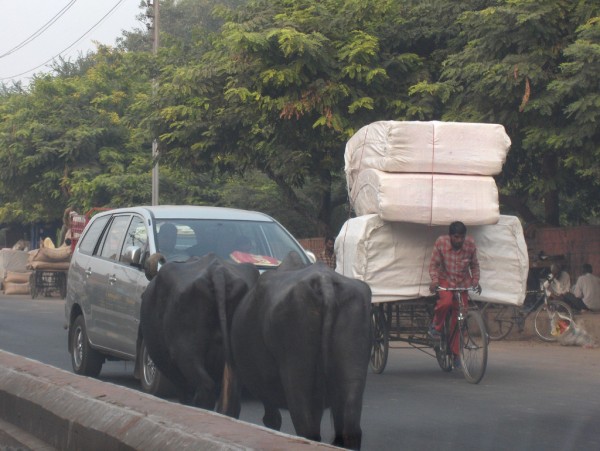
Indian road. Photo by John Haslam. Creative Commons (Flickr: foxypar4)
Everyone has the right-of-way on the roads which is confusing, everyone thinks they own the road which also goes for pedestrians, cows, dogs and donkeys … earlier in the day we came across a guy on the phone rolling with his feet a large gas bottle down the middle of the road, the gas bottle picked up speed and he lost control which didn’t seem to be a problem for him as he continued talking on the phone as the gas bottle picked up more speed and headed straight for us! We swerved and all was fine as it is with Indian roads as there are no rules so no one is doing anything wrong so all is OK … I like it with no rules, but can’t handle the overtaking on blind curves, which is common. (I thought it appropriate to have no full stops when describing the roads here.) (more…)
30
You can view the entire archive of Ven. Roger’s wonderful “Life on the Road with Lama Zopa Rinpoche” blog here.
- Home
- News/Media
- Study & Practice
- About FPMT Education Services
- Latest News
- Programs
- New to Buddhism?
- Buddhist Mind Science: Activating Your Potential
- Heart Advice for Death and Dying
- Discovering Buddhism
- Living in the Path
- Exploring Buddhism
- FPMT Basic Program
- FPMT Masters Program
- FPMT In-Depth Meditation Training
- Maitripa College
- Lotsawa Rinchen Zangpo Translator Program
- Universal Education for Compassion & Wisdom
- Online Learning Center
- Prayers & Practice Materials
- Overview of Prayers & Practices
- Full Catalogue of Prayers & Practice Materials
- Explore Popular Topics
- Benefiting Animals
- Chenrezig Resources
- Death & Dying Resources
- Lama Chopa (Guru Puja)
- Lama Zopa Rinpoche: Compendium of Precious Instructions
- Lama Zopa Rinpoche: Life Practice Advice
- Lama Zopa Rinpoche Practice Series
- Lamrim Resources
- Mantras
- Prayer Book Updates
- Purification Practices
- Sutras
- Thought Transformation (Lojong)
- Audio Materials
- Dharma Dates – Tibetan Calendar
- Translation Services
- Publishing Services
- Teachings and Advice
- Find Teachings and Advice
- Lama Zopa Rinpoche Advice Page
- Lama Zopa Rinpoche: Compendium of Precious Instructions
- Lama Zopa Rinpoche Video Teachings
- ༧སྐྱབས་རྗེ་བཟོད་པ་རིན་པོ་ཆེ་མཆོག་ནས་སྩལ་བའི་བཀའ་སློབ་བརྙན་འཕྲིན།
- Podcasts
- Lama Yeshe Wisdom Archive
- Buddhism FAQ
- Dharma for Young People
- Resources on Holy Objects
- Ways to Offer Support
- Centers
- Affiliates Area
- Teachers
- Projects
- Charitable Projects
- Make a Donation
- Applying for Grants
- News about Projects
- Other Projects within FPMT
- Support International Office
- Projects Photo Galleries
- Give Where Most Needed
- FPMT
- Shop
Translate*
*powered by Google TranslateTranslation of pages on fpmt.org is performed by Google Translate, a third party service which FPMT has no control over. The service provides automated computer translations that are only an approximation of the websites' original content. The translations should not be considered exact and only used as a rough guide.Every second of this human life gives us the freedom to choose between hell and enlightenment, samsara and liberation.






